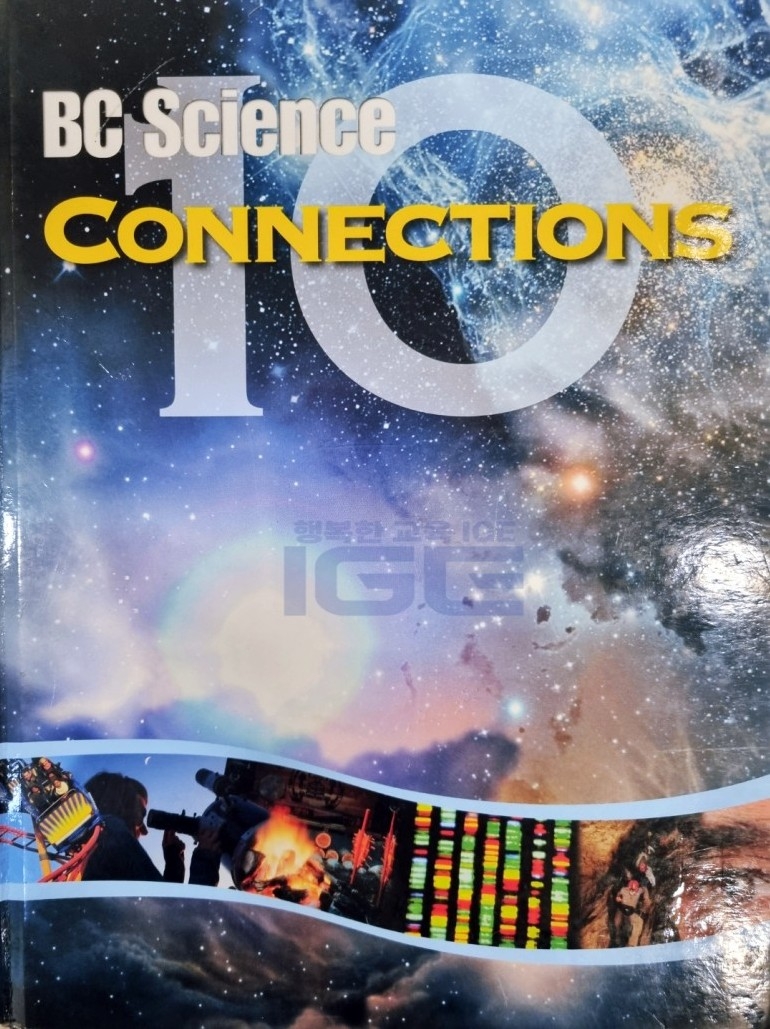10학년 통합과학 - BC Science 10
페이지 정보
본문
캐나다 BC주 세컨더리 10학년에 배우는 통합과학 Science 10 과목에 대해 간략히 설명하도록 하겠습니다. Science 10 과목은 10학년이라면 반드시 이수해야 하는 필수 과목으로 물리, 화학, 생물, 지구과학 4개 영역의 핵심과 기본적인 사항을 배우게 됩니다.
10학년 통합과학은 우리나라의 동일 학년 과정과 비교해 상대적으로 수업 진도가 조금 늦은 편으로 이미 한국에서 배우고 유학 갈 경우 개념보단 먼저 용어에 친숙해지길 추천드립니다.

생물(BIOLOGY)
A. 유전학
(Genetics)
1. DNA에 대한 이해가 생명체 탐구에 어떻게 도움이 되는가?
(How does an understanding of DNA help us investigate living things?)
- 생명체의 변화는 DNA에 의해 발생한다.
(The variation in living things we see around us is due to DNA.)
- DNA는 특정 순서로 연결된 많은 뉴클레오타이드로 구성된다.
(DNA is made of many nucleotides linked together in a specific order.)
- DNA는 수천개의 유전자를 포함하고 있는 염색체에 존재한다.
(DNA exists in chromosomes, which contain thousands of genes.)
- 정보 전달에 중요한 DNA 구조
(The structure of DNA is important to passing on information.)
- 생물의 다양한 유전적 구성은 생명체의 다양성을 반영한다.
(The different genetic make-up of organisms is reflected in the diversity of life.)
2.유전 정보는 한 세대에서 다음 세대로 어떻게 전해지는가?
(How is hereditary information passed from one generation to the next?)
- 유전자는 유전되는 특성을 부모에서 자손에게 물려준다.
(Genes pass on inherited traits from parent to offspring.)
- 퍼네트 사각형은 자손이 특정한 특성을 물려받을 확률을 나타낸다.
(Punnett squares show the probability of offspring inheriting specific traits.)
- 두 대립유전자는 공동 우성으로 표현된다.
(Both alleles are expressed in codominance.)
- 대립유전자는 불전 우성에서 지배적이거나 열성적이지 않다.
(In incomplete dominance, alleles are neither dominant nor recessive.)
- 일부 유전적인 특성은 성염색체의 대립유전자에 기인한다.
(Some inherited traits are due to alleles on the sex chromosomes.)
3. 자연선택과 인공선택이 인구변화에 어떻게 영향을 미치는가?
(How can natural and artificial selection influence changes in populations?)
- DNA 돌연변이는 집단 내에서 유전적 다양성을 창출한다.
(DNA mutations produce genetic diversity within a population.)
- 자연선택은 유기체를 환경에 더 적합하게 만드는 특성을 선호한다.
(Natural selection favours traits that make an organism better suited to its environment.)
- 자연선택은 새로운 종의 생성을 이끌어낼 수 있다.
(Natural selection can lead to the formation of new species.)
- 환경적 요인은 돌연변이를 일으킬 수 있다.
(Environmental factors can cause mutations.)
- 인간은 다음 세대에 물려줄 유기체의 원하는 특성을 선택한다.
(Humans select desired characteristics in organisms to be passed on to the next generation.)
4. 유기체의 유전자는 어떻게 그리고 왜 조작되는가?
(How and why are the genes of organisms manipulated?)
- 살아있는 세포의 DNA는 복제, 변형, 그리고 다른 유기체에 삽입될 수 있다.
(DNA of a living cell can be copied, modified, and inserted into another organism.)
- DNA 기술은 많은 용도로 활용될 수 있다.
(DNA technology has many uses.)
- 생명공학의 사용은 위험성과 윤리적인 문제를 가지고 있다.
(The use of biotechnology has some risks and raises some ethical issues.)


화학(CHEMISTRY)
B. 화학 반응
(Chemical reactions)
1. 화학 작용이 어떻게 우리 삶의 한 부분이 될 수 있나?
(How are chemical processes part of our lives?)
- 응용화학은 우리 실생활 어디에나 존재한다.
(Applications of chemistry are everywhere in the world around you.)
- 화학물질을 다루는 방법을 아는 것은 우리와 우리 주변 환경을 안전하게 유지하도록 도와준다.
(Knowing how to handle chemicals helps keep us and our environment safe.)
2. 화학 반응에서 원자는 어떻게 되는가?
(What happens to atoms in a chemical reaction?)
- 원자는 서로 결합하여 이온 화합물과 공유 결합 화합물을 형성한다.
(Atoms bond together to form ionic and covalent compounds.)
- 탈결합, 원자 재배열, 새로운 결합 형성
(Bonds are broken, atoms are rearranged, and new bonds are formed.)
- 질량은 화학 반응에서 생성되거나 파괴될 수 없다.
(Mass cannot be created or destroyed in a chemical reaction.)
- 화학 방정식은 반응중인 원자에서 일어나는 것을 나타낸다.
(A chemical equation represents what happens to the atoms in a reaction.)
3. 에너지는 화학 작용에 어떻게 관여하는가?
(How is energy involved in chemical processes?)
- 물질과 에너지는 물리 변화와 화학 변화에서 상호작용을 한다.
(Matter and energy interact in physical and chemical changes.)
- 에너지는 화학 반응과 주변 환경 사이에서 전달된다.
(Energy is transferred between chemical reactions and the surroundings.)
4. 원자가 다른 종류의 화학 반응에 어떻게 재배열되는가?
(How do atoms rearrange in different types of chemical reactions?)
- 화합물은 합성 반응에서 형성되고 분해 반응에서 분해된다.
(A compound forms in a synthesis reaction and breaks down in a decomposition reaction.)
- 치환 반응에서 원소는 다른 원소를 대체한다.
(In replacement reactions, elements replace other elements.)
- 대부분의 연소 반응은 열과 빛을 방출한다.
(Most combustion reactions release heat and light.)
- 중화 반응에서 산은 염기와 반응한다.
(In a neutralization reaction, an acid reacts with a base.)


물리 (PHYSICS)
C. 에너지 변환
(Energy transformations)
1. 에너지의 성질은 무엇인가?
(What are the properties of energy?)
- 에너지는 시스템에 변화를 일으킨다.
(Energy can produce change in a system.)
- 에너지는 여러 형태로 존재한다.
(There are different forms of energy.)
- 에너지는 전달되거나 변화될 수 있다.
(Energy can be transferred or transformed)
- 다른 변수들은 다른 형태의 에너지에 기여한다.
(Different variables contribute to different forms of energy.)
2. 에너지는 어떻게 변환되는가?
(How is energy transformed?)
- 에너지는 화학 반응으로 변환된다.
(Energy is transformed in chemical reactions.)
- 에너지는 핵반응으로 변환된다.
(Energy is transformed in nuclear reactions.)
- 빛에너지가 물질과 상호작용할 때 에너지가 변환된다.
(Energy is transformed when light energy interacts with matter.)
3. 에너지 변환이 글로벌 시스템에 어떤 영향을 미치는가?
(How does energy transformation affect global systems?)
- 지구는 에너지가 변환되는 시스템이다.
(Earth is a system in which energy is transformed.)
- 지구의 대기는 태양 에너지와 열 에너지의 변환과 전달에 의해 가열된다.
(Earth’s atmosphere is heated by the transformation and transfer of solar energy and thermal energy.)
- 에너지 전달과 에너지 변환은 지구의 온도를 알맞게 조절한다.
(Energy transfer and energy transformation moderate Earth’s temperature.)
- 에너지 전환과 전달은 해양 생태계와 육상 상태계를 해칠 수 있다.
(Energy transformation and transfer can harm aquatic and terrestrial ecosystems.)
4. 에너지 변환이 인간에게 어떠한 영향을 미치는가?
(How does energy transformation affect humans?)
- 에너지 변환은 이점이 있지만 해로운 위험성도 존재한다.
(Energy transformations provide benefits, but not without risk of harm.)
- 인류는 에너지 전환의 해로운 영향을 줄이기 위해 기술을 개발하고 조치를 취한다.
(We take action and create technology to reduce the harmful impacts of energy transformation.)
- 인류는 에너지 전환의 해로운 영향을 줄이기 위해 착오, 그리고 서로간 협력을 통해 배웁니다.
(We learn from our mistakes and each other to reduce harmful impacts of energy transformation.)


지구과학(EARTH SCIENCE)
D. 천문학
(Astronomy)
1. 우주는 무엇이며 인류는 어떻게 우주를 이해할 수 있는가?
(What is the universe, and how do we make sense of it?)
- 우주는 사람마다 다르게 해석한다.
("Universe" is understood as different things to different people.)
- 우리가 우주를 어떻게 인지하는지는 우리가 언제, 어떤 사람이고 무엇을 알고 있느냐에 따라 달려있다.
(The sense we make of the universe depends on who we are, when we are, and what we know.)
2. 우리가 눈으로만 볼 수 있는 것을 바탕으로 우주에 대해 무엇을 알 수 있는가?
(What do we know about the universe based on what we can see only with our eyes?)
- 우리는 하늘에 나타나는 다양한 물체들을 대부분 예측할 수 있는 방법으로 본다.
(We see a variety of objects that appear in the sky in mostly predictable ways.)
- 우리가 보는 물체의 모양과 움직임은 천체 모형을 사용하여 설명할 수 있다.
(The appearance and motions of the objects we see can be described using a model called the celestial sphere.)
3. 기술이 우주에 대한 우리의 지식과 이해를 어떻게 확장시켰는가?
(How has technology expanded our knowledge and understanding of the universe?)
- 우리는 망원경과 우리의 시각을 넓히고 향상시키는 다른 장치들을 발명했다.
(We have invented telescopes and other devices that extend and enhance our sense of sight.)
- 우리는 우리 은하가 우주에 있는 수많은 수십억 개의 은하들 중 하나일 뿐이라는 것을 알고 있다.
(We know that our Milky Way galaxy is just one of many billions of galaxies in the universe.)
- 별과 은하는 매우 먼거리로 떨어져 있다.
(There are vast distances separating stars and galaxies.)
- 별의 특성은 우리가 별의 수명 주기를 이해하는데 도움을 준다.
(The properties of stars help us develop an understanding of their life cycles.)
4. 우리가 우주에 대해 알고 있는 것을 설명하기 위해 빅뱅 이론을 어떻게 사용하는가?
(How do we use the big bang theory to explain what we know about the universe?)
- 빅뱅 이론은 적색편이와 우주배경복사라는 두 가지 주요 증거에 기초한다.
(The big bang theory is based on two main sets of evidence: redshift and cosmic background radiation.)
- 빅뱅 이론은 우주의 구성 요소들이 어떻게 형성되고 시간이 지남에 따라 변화해 왔는지를 설명하는데 도움을 준다.
(The big bang theory helps us describe how the components of the universe formed and have changed over time.)
- 우주에 대해서는 아직 설명할 수 없는 것이 많다.
(There is much about the universe that we still cannot explain.)


세컨더리 10학년 통합과학 Science 10 과목 학습 내용 한눈에 볼 수 있도록 표로 정리합니다.


각 영역별 요약 내용 및 핵심 용어
생물

화학

물리

지구과학

- 이전글세컨더리 9학년 수학 MathPower 9 22.01.06
- 다음글 캐나다 세컨더리(고등학교) 9학년 과정의 사회과목(social study) 소개 1편 22.01.12
댓글목록
등록된 댓글이 없습니다.




회원가입/로그인 후 댓글 남겨 주세요.
로그인/회원가입